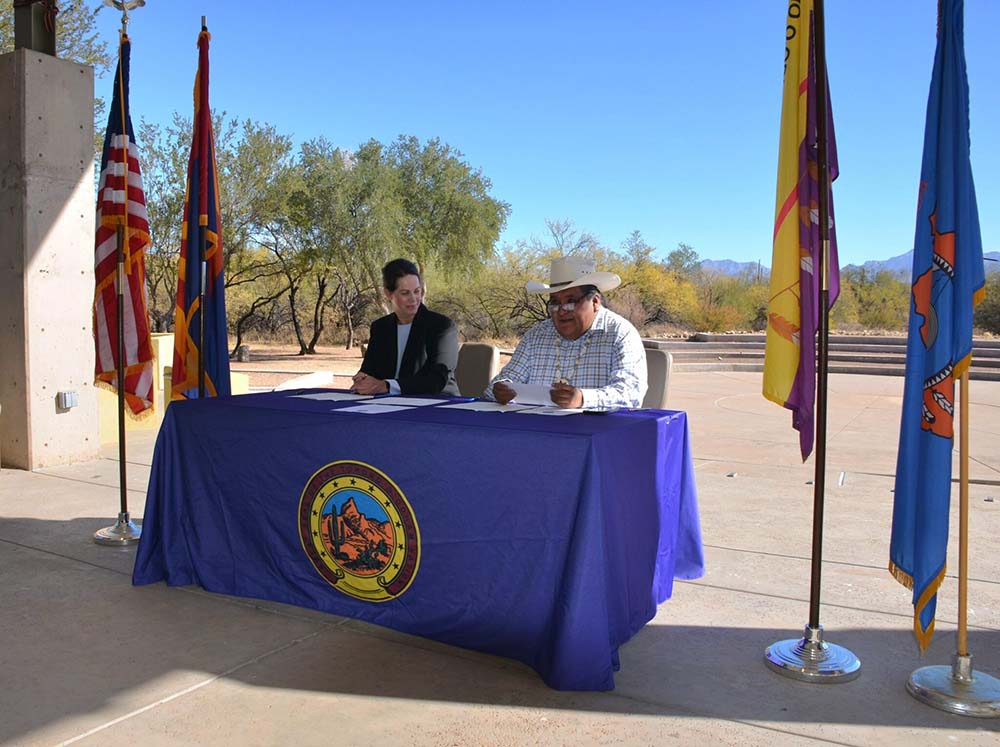
- Details
- By Shondiin Silversmith, Arizona Mirror
The Tohono O’odham Nation signed a co-stewardship agreement with the U.S. Bureau of Land Management for federal lands with deep cultural and religious ties for the tribal nation.
This story was originally published in the Arizona Mirror.
“This agreement will ensure that the Nation has a voice and an active role in protecting these ancestral lands that are so important to our people,” Tohono O’odham Nation Chairman Verlon Jose said in a press release.
The Tohono O’odham Nation is a federally recognized tribe in southern Arizona with about 28,000 tribal members. Its reservation is the second largest in the state and extends from the outskirts of southwestern Tucson to the Mexican border.
The co-stewardship is for the Baboquivari and Coyote Mountains, including the Baboquivari Peak Wilderness and Coyote Mountains Wilderness areas. The agreement allows the tribe and the BLM to collaborate on conservation and management efforts for the wilderness area.
“This is something the (Tohono O’odham) Nation has wanted for years,” BLM Tucson Field Manager Colleen Dingman said. The tribe approached the agency multiple times over the years, and they were finally able to accommodate the request this past fall.
The tribe and BLM signed the agreement during a ceremony held on Dec. 23 at the Tohono O’odham Nation Cultural Center and Museum.
“I’m excited about what this opportunity could present,” Dingman said, adding that it would allow the BLM office in Tucson to grow and learn more from the tribe about how to best protect the area.
The co-stewardship agreement is consistent with a 2021 Joint Secretarial Order directing federal land and water management agencies to facilitate such agreements with tribes to better protect tribal religious and cultural interests as part of the federal government’s trust responsibility to tribes.
Dingman said that the tribe and BLM worked together to develop the intergovernmental cooperative agreement that allows both entities to utilize the expertise of the tribal members, incorporating traditional knowledge and resources toward the best ways to preserve the area and share knowledge.
By partnering together, Dingman said any potential projects or work occurring within the wilderness areas allows the agency to reach out to the tribe for input and listen to ways they can mitigate any impacts or concerns the tribe may have.
Dingman said the tribe and BLM have committed to meeting quarterly to discuss the area’s priorities and how the agency can ensure that the tribe and its members can access their sacred sites and other culturally significant places.
The Tohono O’odham have deep cultural and religious ties to the Baboquivari Mountain Range and Baboquivari Peak, viewing the land as the sacred dwelling place of I’itoi, the Tohono O’odham creator.
“It has been the work of many years to achieve this agreement, which will benefit tribal members and the public for generations to come,” he added. “We appreciate the productive working relationship with the BLM and we look forward to collaborating with them to provide the best possible stewardship for these areas.”
When the tribe’s main reservation was established in 1917, only the western portion of Baboquivari Peak and the Baboquivari Mountains were included in the boundaries established by the federal government.
These wilderness areas include 2,040 acres on the eastern side of Baboquivari Peak and 5,080 acres in the adjacent Coyote Mountains, bordering the Nation’s reservation. The BLM also manages an additional 2,247 acres of non-wilderness lands in the Baboquivari Mountains.
Dingman said the co-stewardship agreement has no expiration date, but the tribe and BLM must reevaluate it in 10 years. If no changes are presented, it will continue.
Shondiin Silversmith is an award-winning Indigenous journalist from the Navajo Nation who has covered Indigenous Affairs for over 14 years. She currently focuses on Arizona's 22 federally recognized tribal nations. Her stories have appeared in local and national news publications across the country. Silversmith earned a master's degree in journalism from Northeastern University in Boston and is pursuing a Ph.D. at Arizona State University. She is an active member of the Indigenous Journalists Association and is committed to amplifying Indigenous voices and storytelling through journalism. She has made it a point in her career to advocate, pitch, and produce stories about Indigenous communities in every newsroom she's worked in.
Help us defend tribal sovereignty.
At Native News Online, our mission is rooted in telling the stories that strengthen sovereignty and uplift Indigenous voices — not just at year’s end, but every single day.
Because of your generosity last year, we were able to keep our reporters on the ground in tribal communities, at national gatherings and in the halls of Congress — covering the issues that matter most to Indian Country: sovereignty, culture, education, health and economic opportunity.
That support sustained us through a tough year in 2025. Now, as we look to the year ahead, we need your help right now to ensure warrior journalism remains strong — reporting that defends tribal sovereignty, amplifies Native truth, and holds power accountable.
 The stakes couldn't be higher. Your support keeps Native voices heard, Native stories told and Native sovereignty defended.
The stakes couldn't be higher. Your support keeps Native voices heard, Native stories told and Native sovereignty defended.
Stand with Warrior Journalism today.
Levi Rickert (Potawatomi), Editor & Publisher
